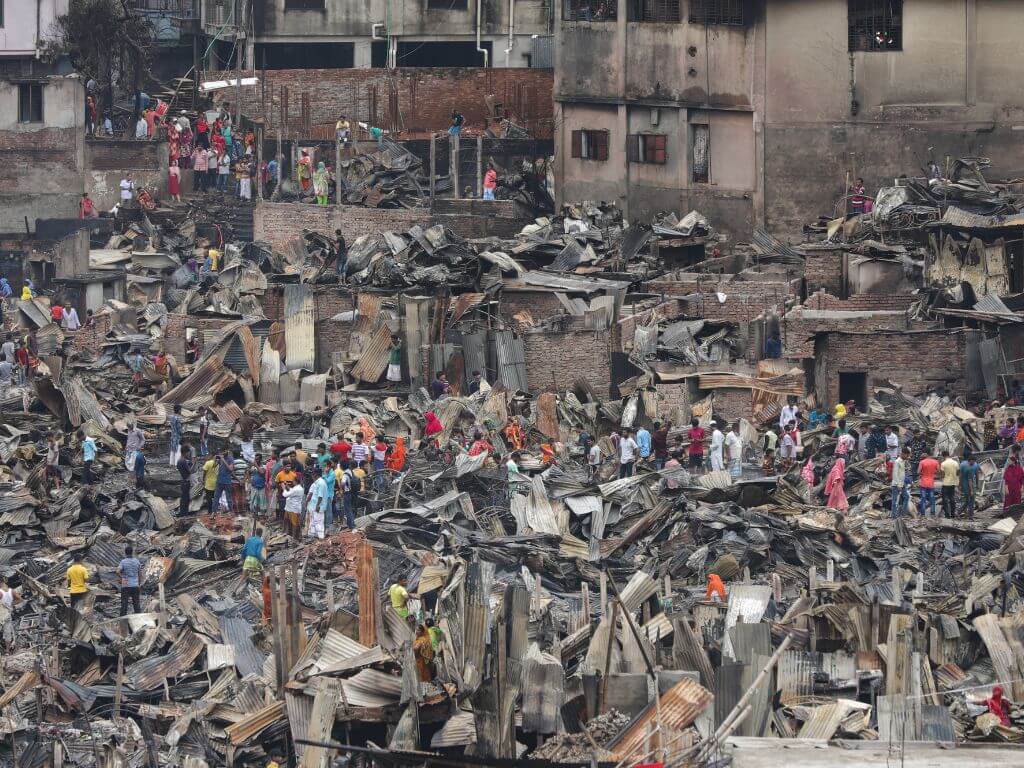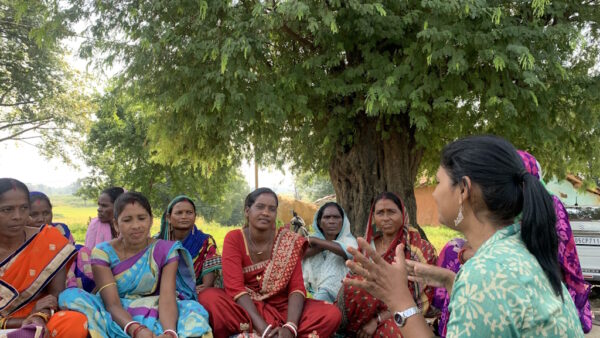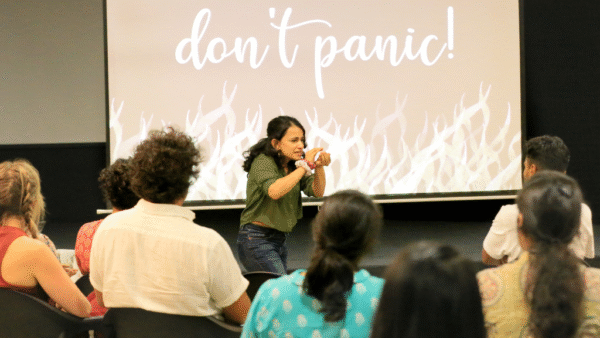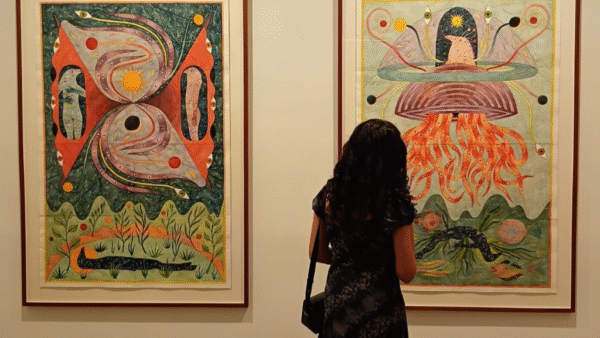Around 130 metres west of the busy Beribandh Tin Rastar Mor, an intersection of three arterial roads in the Basila area of Dhaka, capital of Bangladesh, stands a slum on a low-lying 4.5-acre land. The Chand Udyan Sona Miartek Basti, as the slum is called, can be reached through a muddy road sloping six feet down from the Basila Road. The slum shelters around 700 low-income families – rickshaw pullers, motor transport workers, day labourers, cleaners and househelp. They make do with only six toilet blocks, the rooms here are poorly ventilated, the interstitial spaces are filthy and alleys narrow, and the floor tends to be damp at most times. This, by any standards, is an unhealthy environment to live in but it is cheap; the room rent starts from Tk800 ($ 7) per month.
Here, 27-year-old Mohammad Shaon took shelter last year with his wife Nasreen and their six-year-old son. They migrated from Chorkaua, in Barishal district, after their 0.1-acre homestead was eroded by the River Kirtankhola[1]. Shaon has been making a living by paddling a rickshaw in Dhaka, like he used to in Barishal. His monthly income has increased but his dwelling space here is different from his ancestral home, suffocating and small, with barely any amenities. The rented room on a raised bamboo-made platform accommodates only a floor bed, a box for clothes and a few utensils.
“I came here with an empty wallet. Getting a roof for my family was a priority and we got that here. This slum living is uncomfortable but this is the maximum accommodation I can afford,” Shaon said. Like him, an estimated 1,000-2,000 people[2] migrate to Dhaka every day in search of work but compromise with living spaces and basic civic amenities.
Dhaka contributes one-fifth of the GDP of Bangladesh while offering one-third of all jobs.[3] The continued migration from rural Bangladesh, especially the regions hit hard by climate change, to the city has transformed it into a super-dense place housing nearly 44 percent of the country’s urban population. However, basic services elude them. The systems for water supply, garbage collection, healthcare facilities and education are overstressed; housing, a key component of urban life, is unaffordable for most migrants and low-income earners, forcing these vulnerable groups into bastis or slums. With barely one percent of the space in the city, the slums are home to 6.33 percent of its population.[4]
The density is not an issue if services could be provided but this super-high density – the UN’s Habitat data states Dhaka’s density as 44,500 people per square kilometre, the highest in any city in the world – has led to congestion and neglect. Successive governments have allowed a slide and quietly disregard the urban poor’s right to the city. Then, there is the government’s reliance on the private sector to do public work. “For housing, the pro-capitalist government relies heavily on the private sector which never supports housing for the poor,” remarked Dibalok Singha, chairperson of Coalition for the Urban Poor (CUP).[5]
The urban poor’s right to and need for adequate housing is a political issue, Singha added, one that has been willfully ignored. No ruling political party set up a successful housing project for Dhaka’s slum dwellers in the 51 years after Bangladesh’s independence. Governments have met only 7 percent[6] of the annual housing demand while favouring the middle-and upper-income groups disproportionately.[7] The anti-poor discrimination in housing becomes stark.
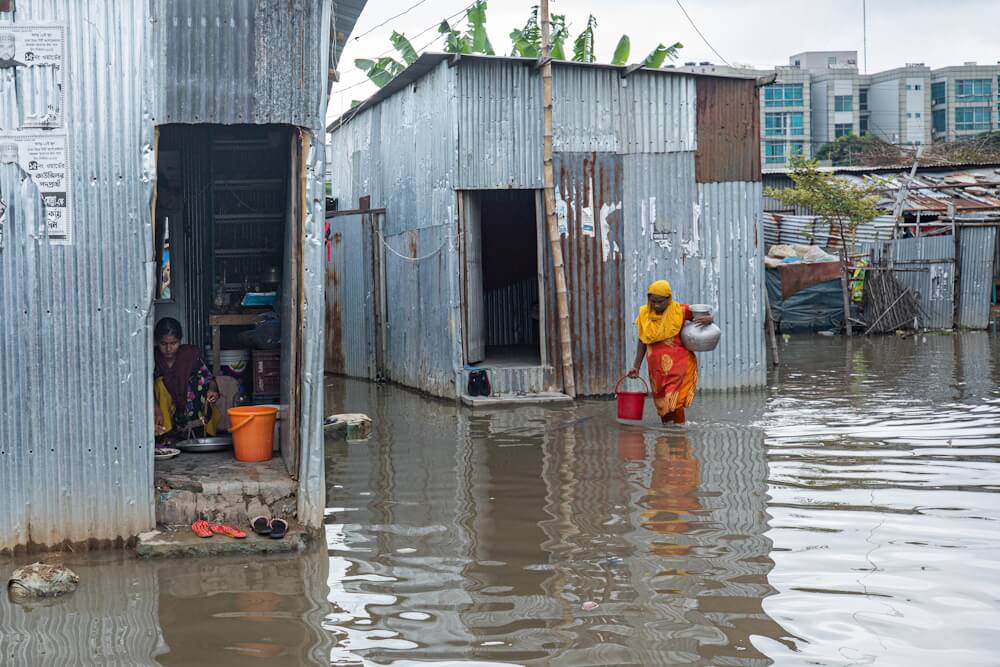
Life in the bastis
Five years ago, middle-aged Noor Jahan accompanied her farmer husband Yunus who migrated from the coastal district of Patuakhali to Kallyanpur Pora Basti in Dhaka. Their home had not eroded but the family had become hugely indebted after crop losses in three consecutive seasons as the untimely rainfall and hail storms wrecked anything standing in the fields. The frequency and intensity of hailstorm—seem to be the big destroyer of crops—have reportedly[8] increased in Bangladesh due to warmer summer.
All the family members have informal jobs: Yunus paddles rickshaw, son Rajib assists a human hauler, Noor Jahan and her daughter-in-law Surma work as domestic help. The four live in a single 10×8 feet shanty in the basti so that they can save money to repay the agricultural loans.
Published in 2021, a study[9] found 28 percent of families in the Kallyanpur Basti are joint and 12 percent are extended families – people somehow making do with minimal room – because of space scarcity. Three-fourths of the people living in bastis and involved in informal jobs earn below Tk10,000 or $90 [when $1=Tk110] a month, which gives a picture of their living standards.
Noor Jahan’s room has no ventilation. After a semi-double bed and a kitchen shelf, only sitting space is left for two or three persons facing the bed. Like others in the slum, her family too competes for a few shared toilets, bathrooms, and water collection points in the basti. Noor Jahan cooks the family’s meals on the three-foot-wide damp archway to the room; indoor air pollution seemed acute there. “Living like this in Dhaka city is unpleasant but we cannot return to our village home unless the loan has been repaid completely with the interest,” Noor Jahan told Question of Cities.

The Kallyanpur Pora (burnt) Basti carries the name after fires gutted the slum, sometimes partially and at other times completely, no less than eight to ten times in the last 30 years. The latest inferno happened in 2022 and damaged more than 300 rooms.[10] At least 3,031 families, dwelling in the congested slum in 10 blocks on a 17-acre land of the state-owned House Building and Research Institute (HBRI), live in constant fear of fire. The people suspect that a vested interest group which wants them evicted was behind every fire incident but state inquiries do not support this.
“For work, we go outside this basti every day, leaving our elders and children in such one-room shelters. We cannot concentrate on our job properly but there is no option,” regretted Rawshan Ara, a community-based organisation worker in Kallyanpur Pora Basti.
A house[11] should be a place where people have protection, feel safe and secure from hostile forces, can function with comfort and satisfaction, and enjoy personal privacy in an environment which includes all services necessary for physical and social well-being. The condition of Kallyanpur Pora Basti turns this idea on its head; this situation prevails in all the slums in Dhaka. A 2021 study[12] identified livelihood conditions in the city’s slums as substandard with limited household resources and public goods, and poor quality of civic amenities.
This has an impact on people’s lives. A social service organisation BARCIK[13] survey in 23 slums in Dhaka in 2017-2018 found that slum dwellers frequently suffered from fever, pneumonia, diarrhea, skin disease, asthma and other diseases due to the environment, said Zahangir Alam who coordinates climate change and adaptation programme of the organisation.
The slums of Dhaka were situated mainly around hazardous industries, water bodies and garbage sites, found the Bangladesh University of Engineering and Technology’s Department of Urban and Regional Planning (URP)[14] in its policy brief[15] in 2022. Professor Afsana Haque, its author, told Question of Cities, “The scarcity of safe housing becomes obvious when a place accommodates more inhabitants than its capacity. The unlivable conditions of the slum dwellers are made worse by the changing climate.”
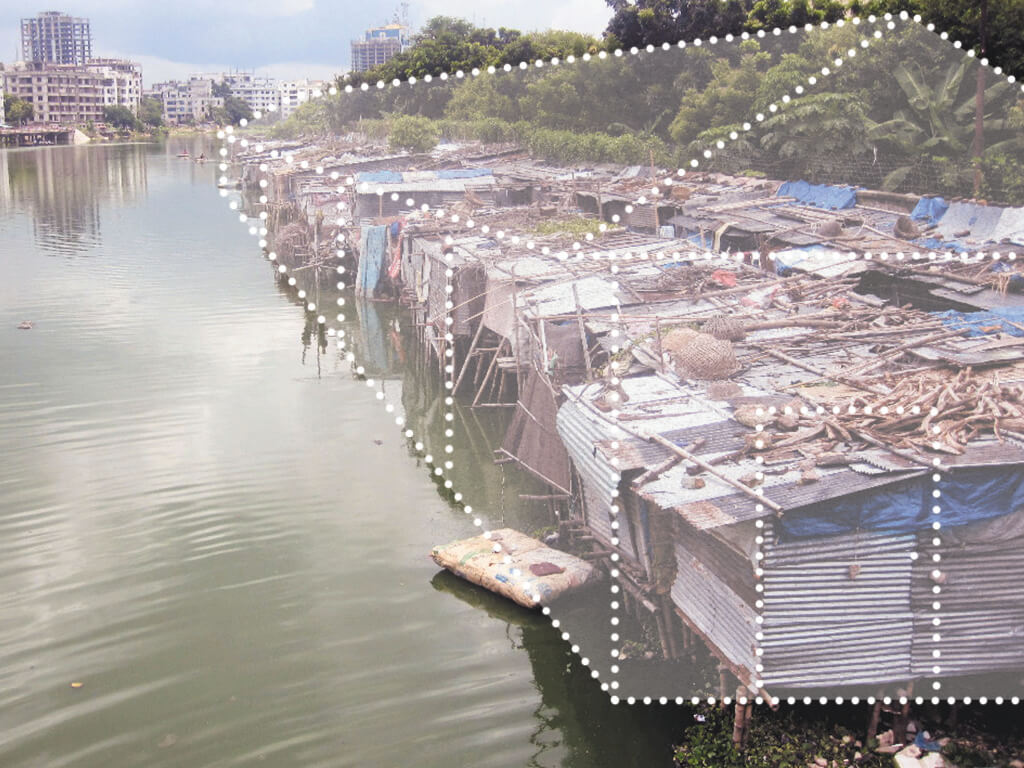
Illustration: Shivani Dave
Falling into climate change trap
The rural-urban migration is the combined effect of push and pull factors. Landlessness, poverty, frequent natural calamities like river bank erosion and tidal surge push people out of their homes while perceived job opportunities and higher wages pull them to cities. One in every three slum dwellers surveyed by BARCIK, or 34.7 percent, migrated to Dhaka due to flood and 21.1 percent due to river erosion in their native homes.
As climate refugees, they become nowhere people, belonging neither to their village nor to the city. The irony is that the climate refugees fall into the trap of natural calamities like urban flooding and heat waves in Dhaka too given that around 78 percent[16] of the large slums are located in low-lying areas like canals, lakes, flood-flow zones while most shanties are constructed with heat-absorbing tin sheets, tarpaulin, and non-durable bamboo.
On September 22 noon, the day after Dhaka witnessed severe water logging[17] due to 113 millimetres of rain in only three hours, Sona Miartek slum dweller Rozina was seen boiling rice, perched on her doorstep. The wooden floor on the raised bamboo-made platform was still wet. Inside the room, her transport worker husband Rubel was looking after their ailing toddler.
“Our house got submerged last night. We didn’t have supper. As the water is receding now, I am preparing lunch,” Rozina said to this writer. Most of her neighbours experienced a similar situation. The daughter had been frequently suffering from fever due to the damp environment, she added. Twelve years ago, Rubel and his family moved to the slum as his ancestral homestead in the coastal district Bhola was completely eroded by the River Meghna.[18] Climate change impact hit them there and here too.
In the poorly ventilated shanties, only electric fans bring some comfort. During the prolonged heatwaves this year, Sona Miartek basti did not have electricity for three months, forcing dwellers to move to other sites. Yesmin, a migrant from Bhola, and her aged mother Amena also shifted to a nearby mess room where the monthly rent was Tk 3,000 ($27). The duo returned to their basti after two months as Yesmin could not afford the high rent. “With my meagre income, managing our daily meals is challenging. How could I afford a costly room outside the slum?” she asked.
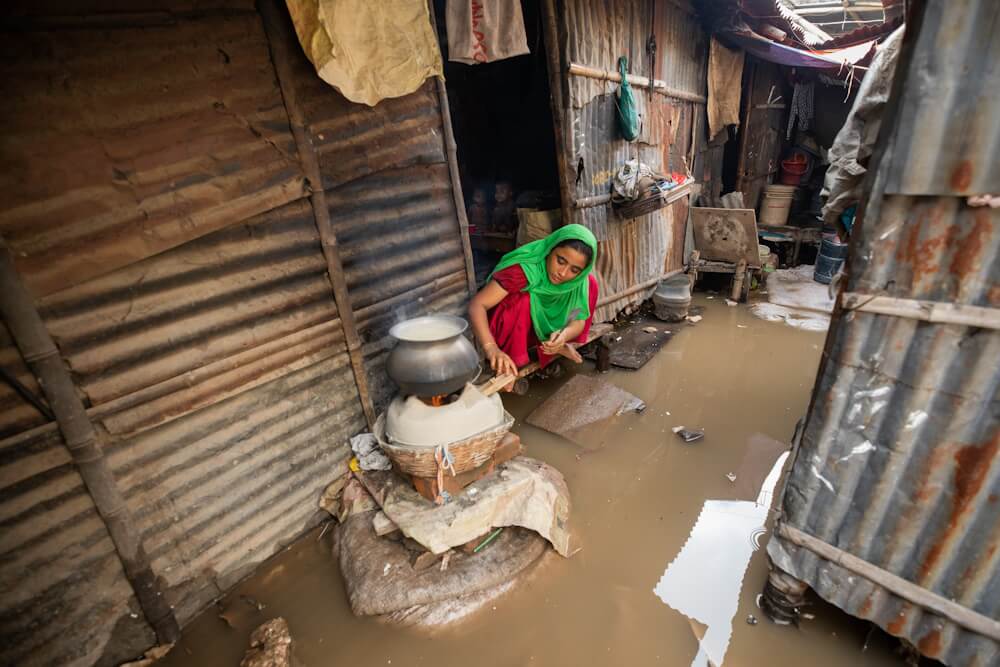
Rejected from housing right
This hits hard because shelter or housing is a constitutional right[19] of citizens in Bangladesh. It has been reiterated in the government’s promises to many international conventions including the Covenant of Social, Economic and Cultural Right (ICSECR)[20] and the United Nations (UN) Istanbul Declaration on Human Settlement (1996).[21]
The National Housing Policy,[22] which provides guidelines to ensure ‘housing for all’, blames organisational weakness and scarcity of resources in the prevailing system for keeping a large section of people out of institutional financing for housing.
Defining the government’s responsibilities towards the lower-middle income, lower-income, and the poorest, the policy states: “…the government will play the role of provider. In such a context also, it would be tried to recover the cost or limit the cost through cross subsidy as far as possible.”
However, an unpublished report by BUET’s urban department finds unavailability of subsidiary financial plans for the urban poor. The lone public housing finance entity Bangladesh House Building Finance Corporation (BHBFC) holds less liability for the housing mismanagement. According to Bangladesh Bank,[23] the total outstanding housing loans amounted to Tk1058.94 billion ($11.35 billion*) in June 2022. Of this, only Tk39.3 billion ($0.42 billion*) was disbursed by BHBFC while the rest had come from private-run housing finance companies, banks and other financial organisations. *[Tk-USD exchange rate of 2022].
The BHBFC does not finance housing for the urban poor[24] in Dhaka, Chattogram or Sylhet while the private finance sector offers nothing to the poor. The required documents[25] for a loan application at the Delta Brac Housing Finance Corporation, the largest private-run housing finance company, include salary certificates, land ownership documents and trade licences which slum dwellers can hardly provide.
“The urban poor’s right to the city is deliberately ignored in the housing finance schemes,” opined CUP chairperson Dibalok.
The National Housing Policy encourages community and cooperative-based voluntary housing programme for slum dwellers, but it is on paper. On the ground, the government involved private contractors instead of community organisations in two projects meant for low-income groups; these failed to accommodate slum dwellers. The private contractor for the Bhasantek project sold apartments to the well-off rather than to slum dwellers[26] despite evicting nearly 2,500 families for the land while no one from the low-income group was found owning a flat in Rajuk’s Uttara project, a report[27] of the Implementation Monitoring and Evaluation Division revealed in 2019.
In the former, none of the evicted could find homes, forcing nearly 400 families to build makeshift cottages on the land. Abul Hossain is among them. The public-private project set a subsidised price of Tk1.9 lakh ($2,321.04*) for 215 square feet flat; beneficiaries had to contribute Tk10,000 ($122.16*) down payment and Tk1,100 ($13.44*) as monthly installment over 10 years. “We could pay the money but the local ward councillor didn’t certify us as slum dwellers. Our applications for the flats were rejected,” said Hossain. *[Tk-USD exchange rate of 2012]
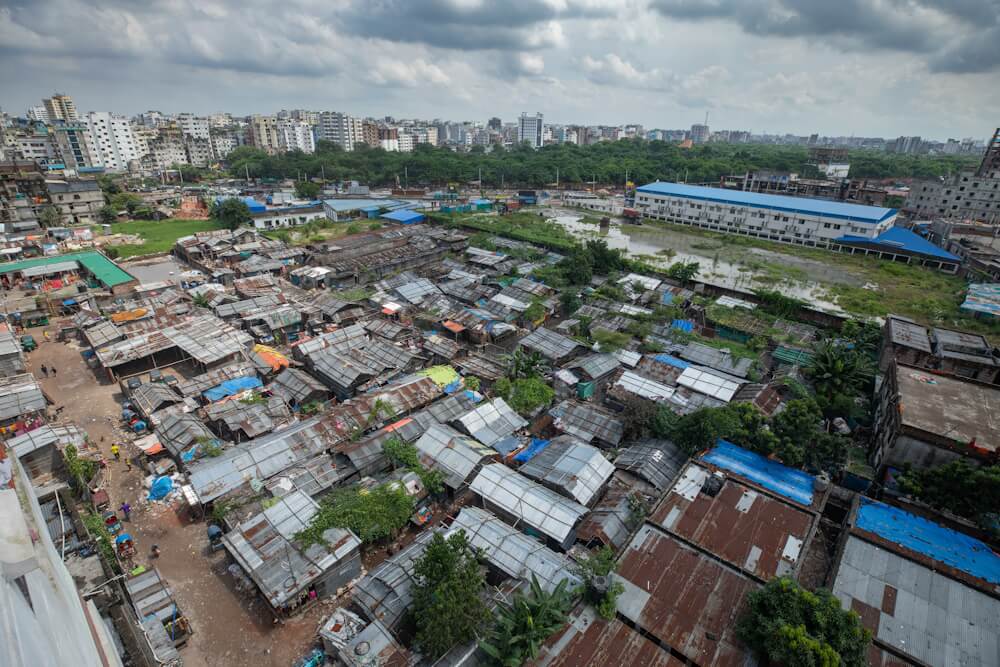
Searching for a positive change
Despite the dismal situation, the NGO Association for Realisation of Basic Needs (ARBAN) was a successful implementor[28] of a housing project for urban poor in Mirpur, Dhaka. Under the project, 38 small-size flats were handed over to the beneficiaries in 2012. Collecting a lump sum Tk20,000 ($214.31) as initial deposits from each beneficiary, ARBAN purchased 0.1acre land in Mirpur and constructed a multi-storey building in 10 years, housing 38 families or around 200 people.
However, this initiative had multiple challenges including delayed recovery of construction cost. “Many beneficiaries had shifted to the flats on humanitarian grounds but dilly-dallied in paying the installments,” recalled Mahbubur Rahman, project coordinator at ARBAN. The lessons from the Mirpur project later forced ARBAN to revise its policy. Now, its under-construction project of 90 low-cost flats in Dhaka’s Rampura area will not be handed over till all payments are made. But the weight should not fall on NGOs. Dibalok Singha believes that the government should shoulder the responsibility of minimising the risk factors of low-cost housing while a housing finance savings scheme can be an effective instrument.
The Detailed Area Plan (DAP) 2022-2035 proposes at least 58 locations in Greater Dhaka for housing low-income groups. The project director and town planner at Rajdhani Unnayan Kartipakkha, or Capital City Development Authority, Md Ashraful Islam, told Question of Cities, that the subsidised-price flats would be built but in phases. The Bhashantek and Uttara cases, however, create a concern. “First, it is necessary to ascertain whether the government wants to reduce the inherent discrimination within the society. The examples set by the government so far do not assure us,” Dibalok said.
Buffeted by climate impact in both their villages and in Dhaka, the story of the low-income groups in the city shows why adequate and affordable housing should become a part of climate change discussions.
Sadiqur Rahman, a post-graduate of the University of Dhaka, is currently employed as a journalist in The Business Standard. His 10-plus-year career in journalism includes reporting on Climate Change, biodiversity conservation, local business, and livelihood-related issues. A member of the Thomson Reuters Foundation Alumni Club, Bangladesh, he won two anti-corruption media awards in 2014.
This is the third part of a series supported by the QoC-CANSA Fellowship to report on Climate Change and cities in four nations of South Asia. The first essay details the climate change impacts in Dhaka, Narayanganj and Gazipur; the second essay focuses on the inadequate healthcare facilities in Dhaka.
Cover photo: Mirpur Chalantika slum was completely destroyed in the 2019 floods.
Photos: Rajib Dhar

